Recording working hours is mandatory with immediate effect – this was decided by the German Federal Labor Court (BAG), which published the grounds for its ruling at the beginning of December. In this article, we will explain what time tracking is all about, what will change in the future, and why companies should already introduce appropriate systems.
What is time tracking and why is it so important?
Time tracking is the documentation of the daily working time of each employee in a company. Working time includes the period during which an employee must fulfill his or her work obligation, but not breaks or rest periods. What may sound like monitoring or restriction to some people is, however, of great importance, especially with regard to occupational health and safety. According to the President of the BAG, Inken Gallner, time tracking is a "protection against external and self-exploitation". The accurate and correct recording of working time helps to obtain an overview of the work done. Were rest periods observed? Was overtime recorded? Were the maximum working hours not exceeded? With the help of a time-tracking system, the employer can find answers to these and other questions and intervene, if necessary. And employees are also on the safe side and can document exactly when they may have worked overtime.
The current legal situation on time tracking
In recent years, the topic of recording working time has become increasingly relevant. Until now, German law only required employers to record working time exceeding the working day, i.e. overtime and work on Sundays and public holidays. With the "Time Clock Ruling", the ECJ decided in 2019 on an obligation to record working time that goes beyond this: All EU member states must require employers to introduce an "objective, reliable and accessible system" for recording working time. The ruling has triggered uncertainty and speculation among German companies over the past three years, as no provisions for implementation at the national level have been specified during this time.
On September 13, 2022, the BAG announced a decision and thus the obligation to record working hours. With the grounds for the ruling published in December, the BAG now provides employers with more concrete requirements. For example, the mere provision of a working time recording system is not sufficient; working time must actually be recorded. In addition to recording overtime, the start and end of work as well as breaks must be recorded. It should still be possible to guarantee trust-based working time models, as the obligation to record working time may be transferred to the employees themselves. Time recording continues to apply with immediate effect and without a transition period. There is no threat of fines yet, but employers should urgently encourage their employees to record their working hours with an eye to the future. This should be possible both manually and electronically; there is no uniform system for the time being.
The German government will now examine the grounds for the BAG's ruling and has announced a proposal to amend the Working Time Act for early 2023. It will probably be some time before the law and all its requirements are implemented in a practical manner. But one thing is already clear: The introduction of a working time recording system is mandatory. It is therefore advisable for companies to look for such a system in good time. Of course, this means yet another program that all employees have to become acquainted with and that incurs additional costs. It is therefore practical if you are already working with a tool in which working time recording can be mapped in a very uncomplicated way.
Time tracking with Stackfield
There are, of course, a number of ways to record working hours, from time clocks to Excel spreadsheets to handwritten records. What makes sense and what is appropriate is a subject for debate. However, the focus should be on practicability and usability.
In Stackfield, the module Time Tracking was originally introduced for project planning. Especially here it is particularly helpful to keep track of the progress of a project or also to determine how much time is needed for certain tasks. In light of the BAG ruling, there is now another use case for the time-tracking function in Stackfield.
Short guide:
- Create your own room with the task module and the time tracking module
- Configure settings of the room: Start and end time, columns (per month, "Done" status) and individual rights groups
- Define rules, e.g. one task per employee and month, due date, assignment, working time ("Billable", breaks: "Locked"), who may set the status to "Done" and when?
- Enter and evaluate times
When introducing working time recording with Stackfield, it is recommended to first create a room group at the organization level with the title "Time Tracking" and rooms for each department. In the room settings, the task module and the time tracking should be activated in the tab Modules. In addition, the special setting for the start and end time should be activated.
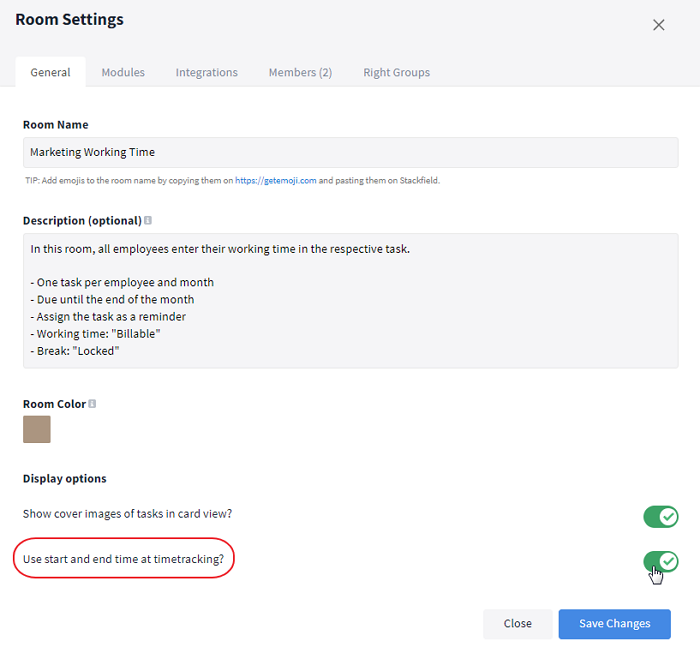
Activate start and end time
Individual right groups should be created for the respective rooms, so that only authorized persons can access certain content. For example, employees should only have access to their own tasks and the HR department to all open tasks. The rights to delete tasks and who is allowed to set tasks to "Done" should also be defined.
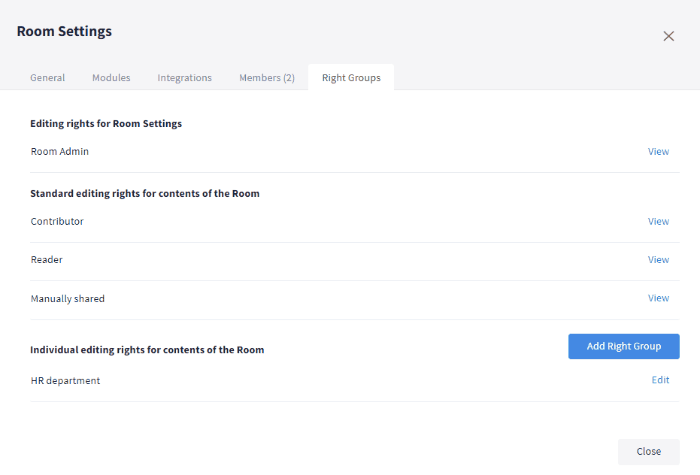
Create individual right groups
Now a column can be created in the Kanban board for each month (and a "Done" status) and one task per employee and month. Each employee enters his or her working and break times here per day. These can either be entered manually or the employee starts the timer (symbol: stopwatch) at the start of work and stops it during breaks and at the end of work. With this option, the entries are created automatically and can be edited afterwards. If required, an estimate for the planned working time including breaks per month can also be entered for a target/actual comparison. In order to distinguish between working time and break time in the bar chart, the working time could, for example, be marked as "Billable" and the time entry for the break could be locked by clicking on the "More" button.
Tip: If the given structures for distinguishing between working time and break time are observed, no additional description needs to be entered. Specify the rules in the room description, for instance.
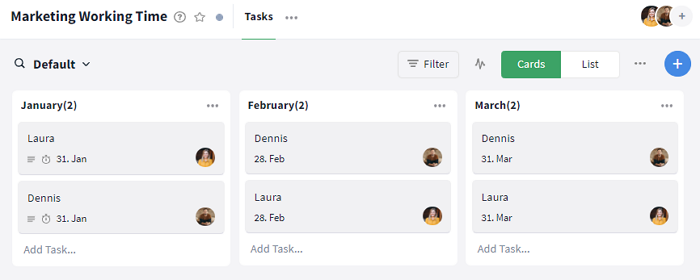
Overview in the Kanban board
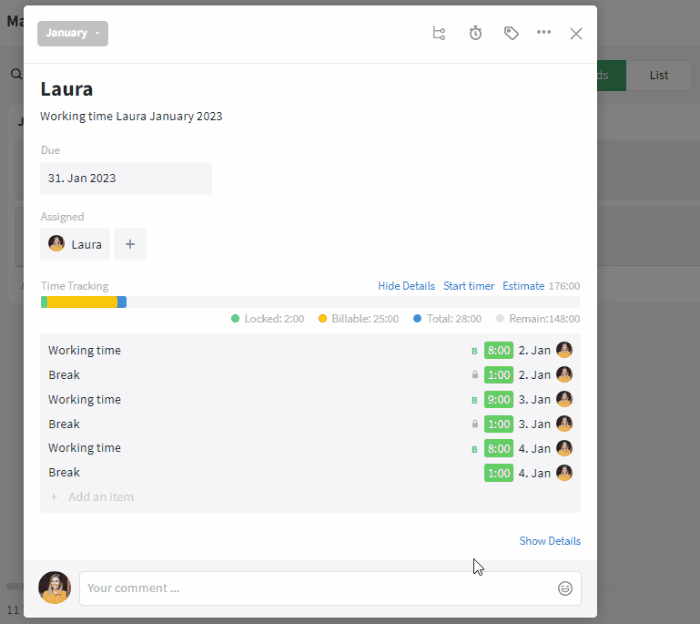
Overview in the task and locking a time entry
For a detailed overview, the columns "Time Tracking" (CO.) with the actual recorded working time and "Estimate" (ES.) with the sum of the estimated working time for the month of the respective task can be additionally displayed in the list view via the filter.
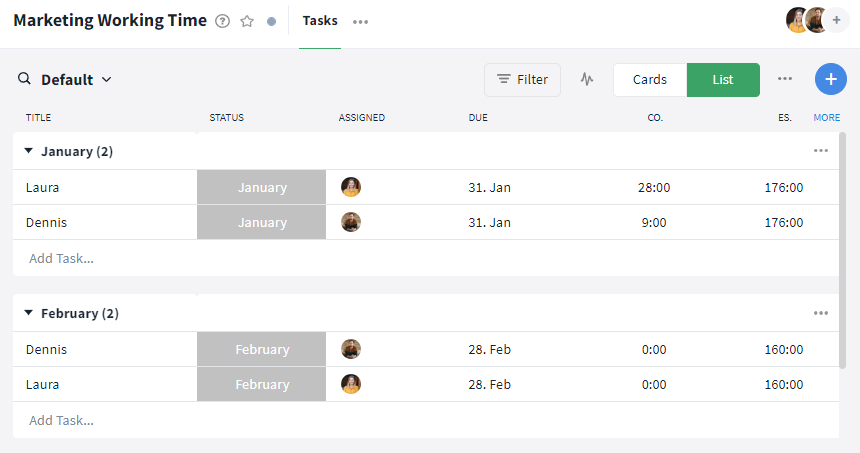
Additional options in the list view
To remind all employees to always enter their working time by the end of the month, the task can be additionally assigned and a due date added. However, in order to avoid a lot of work at the end of the month, it is recommended to always enter the times on the same day and then simply move the due date to the next working day after completion.
Using the Reports function, the working time of all employees for all (open) months can be evaluated and corresponding columns can be shown or hidden and saved. Depending on the desired evaluation, select the time tracking or task module. If necessary, the view can be changed via the filter and/or exported.
Almost finished...Please click the link in the email and confirm your email adress to complete the subscription process.
Never miss a post. Get awesome insights in your inbox.